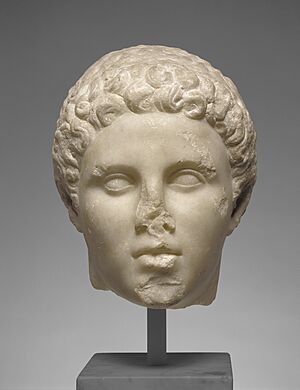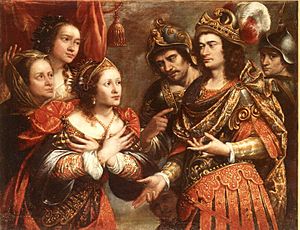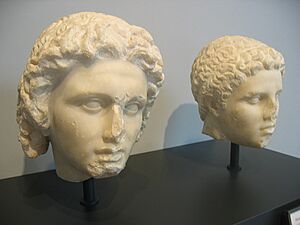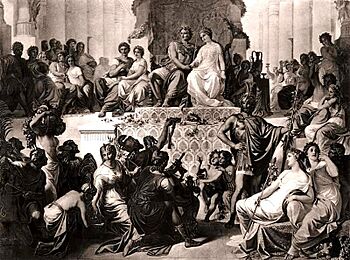Hephaestion facts for kids
Quick facts for kids
Hephaestion
|
|
|---|---|

Hephaestion marble head, as of September 2015 housed in the Getty Museum in Los Angeles, California
|
|
| Born | c. 356 BC Pella, Macedonia, Ancient Greece |
| Died | October 324 BC (aged c. 32) Ecbatana |
| Allegiance | Macedonia |
| Rank | General, 2nd in command. |
| Unit | Somatophylakes |
| Commands held | Companion cavalry |
| Battles/wars | Siege of Pelium, Battle of Thebes, Battle of the Granicus, Siege of Halicarnassus, Siege of Miletus, Battle of Issus, Siege of Tyre (332 BC), Siege of Gaza, Battle of Gaugamela, Battle of the Persian Gate, Siege of Aornos, Battle of the Hydaspes River, Mallian Campaign |
| Spouse(s) | Drypetis (princess of the Achaemenid dynasty in Persia) |
Hephaestion (Greek: Ἡφαιστίων; born around 356 BC – died October 324 BC) was a nobleman and general from Macedonia. He was the son of Amyntor. Hephaestion was the best friend of Alexander the Great. They grew up together and shared all their secrets.
Their friendship was so strong that people compared it to the famous heroes Achilles and Patroclus. Hephaestion was a key leader in Alexander's army. He served as a personal bodyguard and later commanded the important Companion cavalry.
Hephaestion handled many different jobs during Alexander's ten-year journey across Asia. These included talking to other leaders, building bridges over big rivers, and helping to start new cities. He was not just a soldier; he was also an engineer and a diplomat. He even wrote letters to famous thinkers like Aristotle.
Alexander trusted Hephaestion completely. He made him his second-in-command, giving him the title of Chiliarch. Hephaestion also became part of Alexander's royal family. He married Drypetis, who was the sister of Alexander's own second wife, Stateira. Both women were daughters of the Persian King Darius III.
Hephaestion died suddenly at about 32 years old. Alexander was heartbroken. He asked a special oracle to make Hephaestion a divine hero. Hephaestion's ashes were taken to Babylon for a grand funeral. Alexander continued to plan big monuments to his friend's memory until his own death just eight months later.
Contents
Hephaestion's Early Life and Learning
Growing Up with Alexander
We don't know Hephaestion's exact birth date. Most historians believe he was born around 356 BC, just like Alexander. This means they were about the same age. Hephaestion likely became a page in the royal court around 343 BC. This was a common role for young noble boys in Macedonia. It was probably here that he first met Alexander.
There's a story that when Alexander was 15, he and Hephaestion went on a trip together. At that age, Alexander and his friends were studying with the famous teacher Aristotle at a place called Mieza. Even though Hephaestion isn't always listed, his close friendship with Alexander suggests he was also one of Aristotle's students.
We know Hephaestion was well-educated because his name is found in a list of Aristotle's letters. These letters don't exist anymore. But for them to be recorded, they must have been important. This shows that Aristotle was impressed enough to write to Hephaestion, even as Alexander's empire grew.
Staying Close to the King
A few years after their studies, some of Alexander's older friends were sent away by his father, King Philip II. This happened after Alexander tried to marry a princess without his father's permission. Hephaestion was not on the list of those exiled. This might be because he was Alexander's age, and his influence was seen as less of a threat than the older friends.
Hephaestion stayed close to Alexander and the royal court in Pella. His strong friendship with Alexander lasted for many years. Hephaestion's early life and good education prepared him for his future role. He would become the second most powerful person in Alexander's empire.
Hephaestion's Military Career
First Steps in the Army
Hephaestion learned to fight and ride well from a young age, just like Alexander. He probably saw his first battles as a teenager. These included campaigns against the Thracians and the Battle of Chaeronea. His name isn't mentioned among the top officers in Alexander's very early battles. This suggests that he, and Alexander's other friends, earned their promotions through hard work and skill.
Important Missions in Persia
Hephaestion's work wasn't only about fighting. From the beginning, he also took on special tasks. These were sometimes about talking to other leaders or solving technical problems. His first important mission came after the Battle of Issus in 333 BC. Alexander asked Hephaestion to choose the new king of Sidon. Hephaestion picked a gardener who was distantly related to the royal family. This man, Abdalonymus, proved to be a good choice.
After the long siege of Tyre, Alexander put Hephaestion in charge of the fleet. Hephaestion had to sail the ships to Gaza, the next target. This was a tough job because the fleet was made up of many different ships and crews. Once they arrived, he had to unload and rebuild the huge siege machines.
While in Egypt, Alexander wrote a letter to Hephaestion. This suggests Hephaestion was away on an important mission. Some historians think he was helping with diplomacy in Athens. He might have convinced Alexander to make peace with a key Athenian leader. This would have helped prevent a bigger revolt in Greece.
It's also likely that Hephaestion led the army that built a bridge over the Euphrates river. The Persian commander Mazaeus was guarding the other side. Some believe Hephaestion might have talked with Mazaeus. This conversation could have helped Alexander win the Battle of Gaugamela later on.
Fighting Alongside Alexander
At the Battle of Gaugamela (331 BC), Hephaestion is first called the "commander of the bodyguards." This was a small group of close friends who fought right next to the king. Hephaestion was in the thick of the battle. He was wounded by a spear in his arm.
After Gaugamela, Alexander wanted to bring Greeks and Persians together. Hephaestion strongly supported this idea, even though it was unpopular with some Macedonians. Alexander chose Hephaestion to help him treat captured Persian noble families with respect. This showed Alexander trusted Hephaestion's kindness and good judgment.
In 330 BC, Hephaestion became a joint commander of the Companion cavalry. This was a very important cavalry unit. Hephaestion helped them learn new fighting methods. He also helped put down rebellions in new territories.
Leading the Way in India
In 327 BC, Alexander divided his army to enter India. Hephaestion and Perdiccas led a large group through the Khyber Pass. Hephaestion's orders were to conquer all places on their path. He also had to prepare for crossing the Indus River. Hephaestion had to make many decisions on his own in this unknown land. He successfully conquered the area and built boats for the river crossing.
Alexander often divided his forces. He chose Hephaestion for missions where the goals were not always clear. He knew Hephaestion would act just as Alexander would, without needing constant instructions.

Hephaestion played a key role in the Battle of the Hydaspes River in 326 BC. He led a brave cavalry charge. When the army started its journey home, Hephaestion again led half the army. This included the best troops and two hundred elephants. They traveled along the Hydaspes River. Alexander also put Hephaestion first among the "honorary trierarchs," who sponsored the boats. This shows Hephaestion's high rank.
Hephaestion continued to lead important parts of the army. He was in charge of building a fortress and a harbor at Pattala. He also helped establish a city at Rhambacia. Hephaestion shared the difficult journey through the Gedrosian desert with Alexander. When they returned to Susa, he was honored for his bravery.
Hephaestion's military career ended here. He had only a few months left to live. But he was now Alexander's second-in-command in both military and political matters. Alexander made this official by naming him Chiliarch, a very high position.
Hephaestion's Relationships
His Bond with Alexander
Hephaestion's closest relationship was with Alexander. Alexander had many friends, but Hephaestion was his dearest and most trusted. Their friendship began when they were boys. It lasted through Alexander becoming king, through tough campaigns, and even through their marriages.
Their teacher, Aristotle, once said that friendship is "one soul abiding in two bodies." Alexander and Hephaestion seemed to feel this way about each other. After the Battle of Issus, Alexander and Hephaestion visited the captured Persian royal family. The queen, Sisygambis, mistook Hephaestion for Alexander because he was taller. When she realized her mistake, Alexander told her, "You were not mistaken, Mother; this man too is Alexander." This shows how close they were.
Hephaestion himself wrote to Alexander's mother, Olympias, saying, "you know that Alexander means more to us than anything." Alexander, after Hephaestion's death, called him "the friend I valued as my own life." Some historians say Alexander even called Hephaestion his "alter ego," meaning his other self.
Hephaestion was not just a friend; he was also Alexander's partner in everything. Alexander always trusted Hephaestion more and more. As older generals died, Alexander faced problems with loyalty and competence among his officers. Time and again, when Alexander needed to split his forces, he gave half to Hephaestion. He knew Hephaestion was loyal, understood his goals, and would get the job done.
Hephaestion was part of all important meetings. But Alexander also talked to him in private, sharing his deepest thoughts and plans. Hephaestion was the one Alexander relied on to help carry out difficult decisions. At Alexander's first wedding, Hephaestion was the torch-bearer, like a best man. This showed his strong support for Alexander's plan to marry an Asian bride, which was not popular with all Macedonians.
By the time they returned to Persia, Hephaestion was officially Alexander's second-in-command. He was also Alexander's brother-in-law. Historians say Alexander honored Hephaestion as his closest friend and his most important general.
Relationships with Others
Among Alexander's other officers, Hephaestion seemed closest to Perdiccas. They went on important missions together, like conquering Peuceolatis and bridging the Indus River. They worked very well as a team. Their cavalry regiments were chosen for the dangerous crossing of the Hydaspes River before the battle with King Porus. This shows their excellent teamwork.
However, not everyone in the army admired Hephaestion. There were always rivalries and jealousies in the court of a powerful king. But it's surprising how little hatred Hephaestion actually caused. He had a quarrel with Alexander's secretary, Eumenes, over minor things like lodgings. This might have been due to jealousy of Hephaestion's even closer relationship with the king.
Hephaestion also had a serious quarrel with Craterus. Craterus strongly disliked Alexander's policy of mixing Greek and Persian cultures. Hephaestion, however, fully supported it. Their disagreement became so heated that they once drew their swords during the India campaign. Alexander had to step in and scold both of them. This shows how strongly Hephaestion felt about Alexander's wishes.
Hephaestion showed his ultimate loyalty in the summer of 324 BC. He married Drypetis, the daughter of King Darius and sister of Alexander's wife, Stateira. This marriage brought Hephaestion into the royal family. Alexander wanted to be an "uncle to Hephaestion's children." They hoped their children might marry and unite the Macedonian and Persian royal lines.
Hephaestion's Death and Funeral
Hephaestion's Sudden Death
In the spring of 324 BC, Hephaestion left Susa and traveled with Alexander to Ecbatana. In the autumn, during games and festivals, Hephaestion became ill with a fever. The fever lasted for seven days. Alexander was called from the games because Hephaestion was very sick. But Alexander did not arrive in time; Hephaestion had already died.
Some accounts say Hephaestion ignored his doctor's advice. After his doctor left, he ate a large meal and drank wine. Then he became very sick again and died quickly. It's believed that the fever might have been typhoid. The food he ate could have caused internal bleeding, leading to his rapid death.
After Hephaestion died, his body was either cremated or embalmed. His ashes were taken to Babylon. The general Eumenes suggested that Hephaestion be given divine honors, which later happened.
Alexander's Deep Grief
Ancient writers describe Alexander's grief as overwhelming. He ordered many signs of mourning. He had the manes and tails of all horses cut short. He also ordered the battlements of nearby cities to be torn down. All music was banned. For three days after Hephaestion's death, Alexander did not eat or take care of himself. He lay on the ground, crying or silently mourning. He even had Hephaestion's doctor executed for not taking better care of him.
Alexander cut his own hair short as a sign of mourning. This was a sad reminder of Achilles' last gift to Patroclus on his funeral pyre. Alexander also ordered a tribe called the Cossaeans to be massacred as an offering to Hephaestion's spirit.
Alexander ordered a period of mourning throughout his empire. Many of his close companions dedicated themselves and their weapons to Hephaestion's memory. Alexander did not appoint anyone to replace Hephaestion as commander of the Companion cavalry. He wanted Hephaestion's name to always be linked to it. So, it continued to be called "Hephaestion's Regiment."
Messengers were sent to the oracle at Siwa to ask if Hephaestion could be worshipped as a god. The oracle said he could be worshipped as a divine hero, not a god. Alexander was pleased and made sure his friend was honored with a hero's rites. Shrines were built to Hephaestion's memory. A plaque found in a museum even says, "To the Hero Hephaestion."
A Magnificent Funeral
Hephaestion was given a truly magnificent funeral. Some sources say it cost an enormous amount of money, perhaps hundreds of millions of dollars in today's money. Alexander himself helped drive the funeral carriage part of the way to Babylon.
In Babylon, grand funeral games were held in Hephaestion's honor. These contests included literature and athletics. Three thousand people competed. It was the biggest festival ever seen, both in cost and in the number of participants.
Alexander hired a famous artist named Stasicrates to design Hephaestion's funeral pyre. The pyre was sixty meters high and built in stepped levels. Each level was decorated with amazing sculptures. These included ships, torches, hunting scenes, and battles. The top level had sculptures of sirens. These sirens were hollow and hid a choir that would sing a sad song. It's possible the pyre was never burned, but was meant to be a lasting memorial.
One final tribute showed how much Alexander valued Hephaestion. On the day of the funeral, Alexander ordered the sacred flame in the temple to be put out. This was usually only done when the Great King himself died.
Amphipolis Tomb Theory
Based on a symbol found in the Amphipolis Tomb in northern Greece, some archaeologists believe the entire burial mound was a monument for Hephaestion. They think it was built between 325 and 300 BC.
Hephaestion in Stories and Movies
Hephaestion has appeared in many stories and films:
- In the 1961 TV play Adventure Story, Hephaestion was played by William Russell.
- In the 2004 film Alexander, Jared Leto played Hephaestion.
- He is a main character in Mary Renault's novels Fire from Heaven and The Persian Boy.
- He is mentioned in the song "Mystery of Love" from the 2017 movie Call Me By Your Name.
- Indian actor Akash Singh Rajput played Hephaestion in the 2017 Indian TV series Porus.




